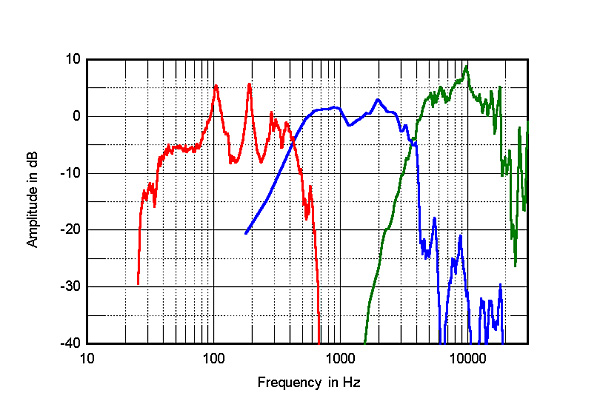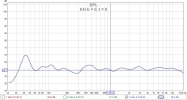Some of my earlier response seen above (re: my Klipschorns w/ Audyssey room correction and room treatment) didn't come through for some reason. Here is the gist of the rest:I love the sound of my Klipschorns (AK5, c. 2002 with Klipsch stock upgrade), in nearly airtight corners, with Audyssey Flat room correction plus tweeking with tone controls, a 4,500 cu.ft room with room treatment including painstakingly adjusted diffusion View attachment 389088 and absorption View attachment 389089, firm walls [(exterior panels, then 3/4" ply, 2X6 studs, glass wool, second layer 3/4 ply (staggered seams), and 5/8" Sheetrock, covered with rough plaster (except where it would hold K-horns out from the wall).
- My K-horns have never sounded "cuppy."
- My K-horns have never sounded "honky" to my ears, anyway. In fact, I noticed that the frequency range called "honk" on the one published chart I have is 450Hz to 1000Hz, a place where the K-horns more or less hug the line (+/- 2.2dB) on my own curve (w/Audyssey and REW) and Klipsch's factory curve (anechoic, except for a wood corner, since that is part of the design). On the Klipsch curve there is one very narrow dip, 1/10 of an octave wide, at 600Hz, supposedly inaudible at that width. So, I'll go with "no honk heard or seen."
- The dynamics would be tough to beat. First, they provide crescendos that are pretty overwhelming, and peaks burst or plunge out mightily in a way that exemplifies Berlyne's cortical arousal increasing variables of surprise, complexity, and, of course, loudness, better than any speaker that I have heard other than the ancient ones I will show below. Secondly, in my room, a typical speaker (90 dB, 2.83v, 1m) would need about 128 watts to reach THX's 105 dB above 80Hz in a very large room. The K-horns would need only about 12 watts to provide the same 105 SPL, and if supplied with the 128 watts that produces the 105 dB with a typical speaker, the Klipschorn would throw 116 dB at us, which is about the SPL of the loudest instaneous peaks of a symphony orchestra. All this is given the likely "true" sensitivity of the K-horns of 101dB, 2.83v,1m -- Klipsch rates them at 105dB, adding the 4 dB to the anechoic measure to reflect the sensitivity in a "typical living room" and, I imagine, to avoid making it seem that the K-horn has lost sensitivity (it hasn't) since the earlier times when it was rated at 104 dB at 4 feet, in a typical living room, or about 54 dB EIA in the olden days.
- If you are lucky enough to encounter Klipschorns (or the new Heritage Jubilee, which is said to be even better) in a store, know that in my wanderings only 43% of Klipschorn pairs have been set up correctly. The older ones need to be pushed fully into a corner, with an air seal, and the new ones need to be very close to a corner.
- In the past, when high fidelity and stereo were young(er), there were some horn speakers that could really move air. I experienced them in 70mm, 6 channel sound movies. They could shake the concrete floor of the theater (the thunderstorm during the crucifixion in Ben-Hur, 1959 and 70mm re-release in 1968). There were no subwoofers, and the big horns did not have a wide frequency response (40 to 10K HZ, as high as 12K or higher with a few, and attenuated bass from just below 40 down to JBL's "usable to 32Hz"). But, man were they clean, tight, with great transients! IMO, they make some newer THX systems sound muddy!
Attachments
Last edited:





